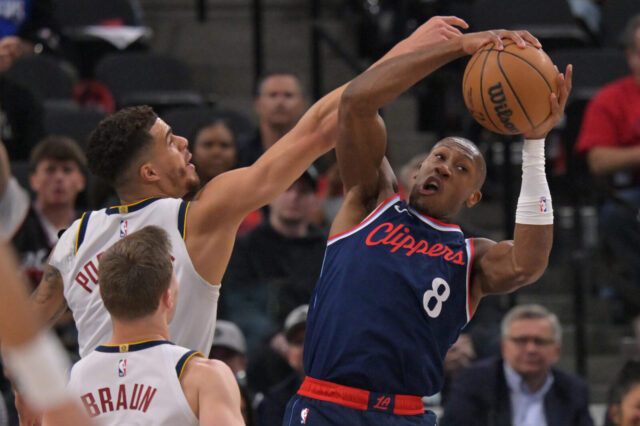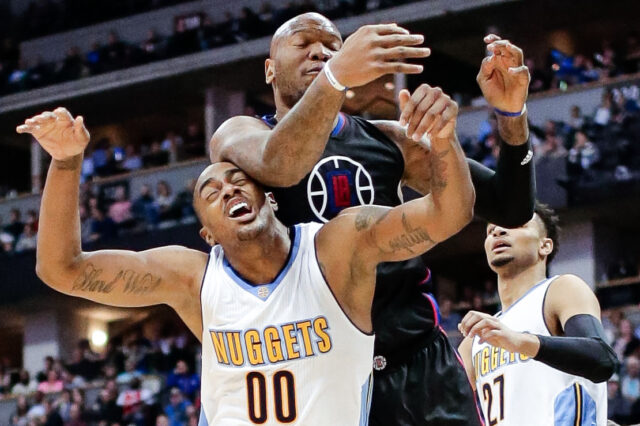The Denver Stiffs will be covering the top prospects for the Denver Nuggets in the 2017 NBA Draft in our Stiffs Prospect Watch series. Check back daily for video, stats, and analysis of top first round prospects.
 Stiffs Prospect Watch
Stiffs Prospect Watch 
| O.G. Anunoby | Semi Ojeleye | Jayson Tatum |
| Lauri Markkanen | Jordan Bell | Terrence Ferguson |
| Jarrett Allen | Jonathan Isaac | Josh Jackson |
Justin Patton – Creighton
| Points | Rebounds | Assists | Steals | Blocks | Turnovers | Field Goal % | Three point % | Free throw % |
|---|---|---|---|---|---|---|---|---|
| 16.3 | 8.2 | 2.4 | 0.6 | 1.1 | 1.5 | 61.70% | 46.60% | 67.90% |
Strengths
Physical Profile
Looking at Justin Patton, I think of Karl-Anthony Towns from a physical perspective. Gifted with the athleticism to run around less athletic bigs and jump over everybody, Patton will be a player who uses his combination of length, strength, speed, and bounce to impact the game. He has a 7’3 wingspan and a 9’3.5 standing reach, so he’s well equipped to be a dominant center in the NBA from a physical perspective.
Efficiency around the rim, lob threat
Combined with his athleticism, Patton also has a solid feel for where to be around the rim. He had a multitude of dunks last year that occurred because of his “lob positioning” near the rim. He made himself available and converted at a high rate. He also has solid touch on many non-dunks, especially in the post and out of the side pick and roll. He could be a “two dunks a game” player, something only 15 players accomplished in the NBA last season on high volume.
Jump shooting potential
Patton shows the semblance of a jump shot in college. He has smooth touch from the perimeter, and he had a number of midrange jumpers and even some threes during his short stint at Creighton. His free throw percentage of 51.7% is incredibly concerning, as is his low attempts. A guy like Towns had an 83.2% mark from the free throw line, so it was easier to see his 3-point shot translating to NBA range. With Patton, it’s merely a potential skill.
Defensive potential
It will be interesting to see how Patton translates on defense. He often got lost on the defensive end, but then there were flashes as a rim protector that young bigs have early in their careers that ease the minds of scouts. Patton is exactly that. He has the physical tools to be a great defender, and even if it doesn’t click, he can still be average. If it clicks though, he could be a real anchor defensively.
Weaknesses
Fundamentals
There are a variety of fundamental things that Patton just doesn’t do well. He doesn’t rebound well, and while that may change with time, it’s a clear weakness. His footwork in the post is pretty solid, but his footwork everywhere else on offense? It’s bad unless he’s in the short corner. He likes to shoot off the dribble at times, and it goes in occasionally, but not frequently enough to justify him taking that shot. Defensively, he’s not good overall at seeing angles and understanding where the opposing team attacks from. He will be eaten alive at the NBA level until his mind catches up to the pace of the game, and while this is something he CAN do, it’s hard to judge how players will evolve.
Rebounding and interior presence
The big difference between a guy like Towns and a guy like Patton is how physical they are on the defensive end. Patton often is muscled around by guys of comparable size, and it translates to the rebounding numbers. To put it in perspective, Zach Collins and Jonathan Isaac far outpaced him in rebounding rate, while Lauri Markannen was his equal. That’s not a good sign for Patton. Furthermore, the block numbers were okay, but Collins and Ike Anigbogu far outpaced him there as well.
Consistency
Patton’s numbers can be separated into two time periods: before and after point guard Marcus Foster’s injury. Foster is a talented player, and his gravity created open lanes for Patton. When Foster exited, Patton’s numbers dipped to merely average. If Patton is to be an impact player at the next level, he will need an elite creator to set him up OR improve in his self-creation looks.
Fit with the Nuggets
The fit with Nikola Jokic, most importantly, is awkward. Patton isn’t mobile enough to chase around wings all game, and his rim protection inside isn’t strong enough to consider the possibility of Jokic chasing wings. If the Nuggets desire a player behind Jokic, Patton is intriguing. He has enough skills to be the focal point of a second unit if developed properly, but on a team in which Jokic SHOULD play 32+ minutes every game, how valuable is spending a lottery pick on 16 minutes a night REALLY?
In an athletic NBA, he projects as a potential option as a starting center for many teams. Not the Nuggets though.
Projected draft spot
SB Nation – 29
Draft Express – 19
Sporting News – 22
CBS Sports – 14 (Forgrave), 13 (Parish)
Final thoughts
Justin Patton is one of my biggest boom or bust candidates. He could go as high as maybe Detroit at 12, and as low as the Spurs at 29. Denver at 13 is basically the top of his range, but that’s due to his potential, not necessarily the safety of the pick.
If developed properly, I see Patton making a Myles Turner level of impact on a team. He’s not going to dominate on the glass, but his physical tools could help him be as good as a solid second option on a playoff team down the line.
That said, I wouldn’t draft Justin Patton at 13th overall. There are other players that fit Denver better now and even more players that fit Denver better three to four years from now. Patton’s role on the team would be small, and with Mason Plumlee, a better player right now, on the roster, it may be a waste of a pick.
Now, if Denver trades down and Patton is the best player on the board, then of course, take him and develop him behind Jokic and Plumlee. Think of it like the Chicago Bulls trade back in 2014, when Denver moved down and selected Jusuf Nurkic and Gary Harris. That’s a viable option if Denver finds the right trade partner.


